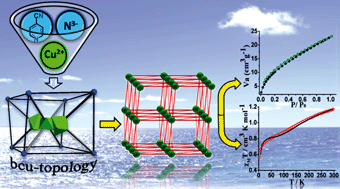A porous metal organic framework with a bcu-type topology involving in situ ligand formation – synthesis, structure, magnetic property and gas adsorption studies†
Abstract
A three-dimensional (3D) porous metal organic framework namely, {[Cu3(N3)2(4-ptz)4(DMF)2]·2DMF}n, has been synthesized using Cu(CH3COO)2·H2O and ligand 4-ptz [5-(4-pyridyl)-tetrazolate] which was formed in situ from 4-cyanopyridine and sodium azide in presence of water and CuII ions. Crystal structure analysis showed that the complex crystallizes in the monoclinic space group P21/c and has a decorated body centred cubic (bcu) topological net with 8-connected Cu3 cluster as node. Magnetic studies exhibit prominent antiferromagnetic interactions influenced by EO (end on) azide and μ2,η2-tetrazolato bridge among the metal centres. Gas adsorption studies reveal moderate carbon dioxide uptake, which is also reflected in the isosteric heat of adsorption (Qst) value of −28 kJ mol−1.


 Please wait while we load your content...
Please wait while we load your content...